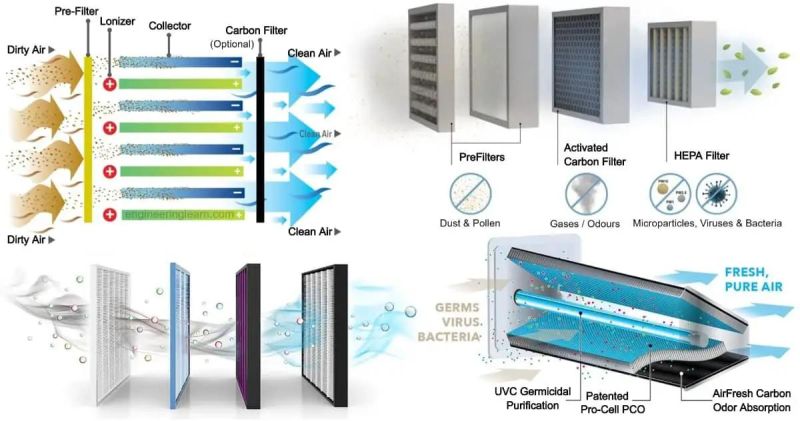In both water and air filtration systems, medium filters play a critical role in removing a wide array of contaminants, enhancing safety and quality. This article explores the capabilities of medium filters, focusing on how they handle different types of pollutants, guided by international standards and best practices.
Key Advantages
- Removes a wide range of particle sizes
- Versatile applications in water and air systems
- Cost-effective filtration solution
- Easy maintenance with backwashing
Applications
- Residential water purification
- Commercial HVAC systems
- Industrial process water
- Laboratory air quality control
What is a hepa filter?
Though primarily associated with air filtration, the principles behind HEPA (High-Efficiency Particulate Air) filters offer insight into filtration technology's effectiveness. hepa filters are designed to capture 99.97% of airborne particles as small as 0.3 microns, setting a standard for particle capture that influences other filtration technologies.

HEPA filter structure showing dense fiber arrangement
How Medium Filters Work
Interception
Particles follow the fluid stream and are intercepted by filter fibers when they come within one particle radius.
Impaction
Larger particles cannot follow curved streamlines and impact directly on filter fibers.
DiFFUsion
Small particles exhibit Brownian motion, increasing their chance of collision with filter fibers.
Medium filters function based on the principles of interception, impaction, and diffusion. The setup involves layered filter media through which air or water passes. As the fluid traverses these layers, particles are trapped, resulting in cleaner output.
Multi-layered filter media in a medium filter system
Key Concepts in Medium Filtration
Filter Media
The choice of filter media is fundamental to a medium filter's performance. Various materials, including cellulose, fiberglass, and polyester, can be used depending on the filter's application. For water filtration, materials are often selected for their specificity in capturing particular contaminants.
Backwashing
To maintain efficiency, backwashing is an essential maintenance step in water filtration. It involves reversing the flow of water to wash away accumulated particles, preventing blockages and maintaining flow rates.
Process: Water flow reversal → Particle dislodgement → Waste discharge → Normal operation
Multi-media Filters
Multi-media filters, combining different filter media, increase efficiency by tackling a wider range of particle sizes and types. This technology allows for solutions that excel in complex filtration tasks, addressing both larger debris and finer particulates.
Water Filtration Capabilities
Sediment and Debris
Medium filters excel in removing large particulates like sand, silt, and rust, which can accumulate in water systems over time. By capturing these, filters protect plumbing and improve water clarity.
Chemicals
Activated carbon medium filters can adsorb chemicals such as chlorine and volatile organic compounds (VOCs), improving taste and safety in water.
Heavy Metals
By employing specific ion-exchange resins, medium filters can remove heavy metals like lead and mercury, contributing to healthier water.
Microorganisms
Some medium filters, particularly those using ceramic or fine membrane layers, can effectively remove bacteria and protozoa, reducing disease risk.
Other Pollutants
Medium filters can also remove unpleasant odors and colors from water, enhancing the overall consumption experience.
Air Filtration Capabilities
Dust and Debris
Medium filters in air systems capture various airborne particulates such as dust, which is crucial for maintaining healthy indoor air quality.
Allergens
Pollen, pet dander, and other allergens are efficiently trapped by air filtration systems using medium filters, providing relief to allergy sufferers.
Other Particles
Medium filters are also effective against smoke particles and smog components, contributing to cleaner, safer indoor air environments.
Frequently Asked Questions
What maintenance is required for medium filters?
Regular replacement or backwashing is needed to maintain efficiency.
Can medium filters remove viruses?
While not specifically designed for viruses, some filters paired with additional treatments can capture virus-laden particles.
Are all medium filters the same?
No, they vary based on application, media used, and specific contaminants to be removed.
Do medium filters remove fluoride from water?
Specialized filters are required to effectively remove fluoride.
How long do medium filters last?
Typically, 6-12 months for Air Filters and varies for water, depending on usage and type.
Can medium filters improve taste and odor in water?
Yes, particularly those with activated carbon layers.
Conclusion
Medium filters stand as versatile and efficient tools in both water and air filtration, capable of capturing a wide array of contaminants. They provide essential protection in residential, commercial, and industrial applications, ensuring the safety and quality of air and water.
 +86 18186671616
+86 18186671616 Jason@cleanroomequips.com
Jason@cleanroomequips.com
 MENU
MENU



